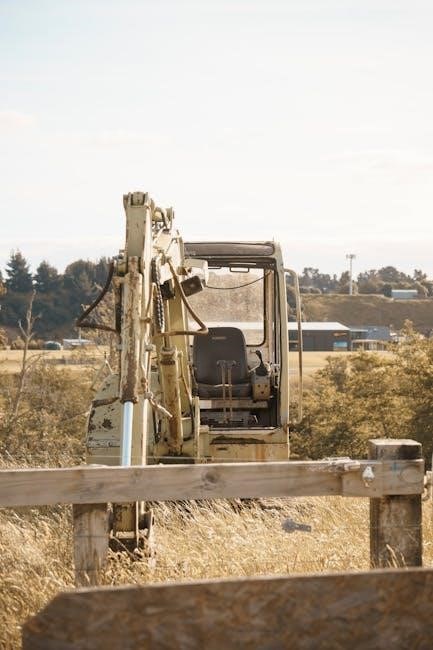Manual excavators are essential tools for digging tasks, offering a cost-effective and eco-friendly solution. They are versatile, simple, and efficient for various applications.
1.1 Definition and Purpose
A manual excavator is a handheld or portable tool designed for digging holes, trenches, and soil preparation. It includes post hole diggers, shovels, and augers, ideal for gardening, landscaping, and small-scale construction. These tools are versatile, cost-effective, and environmentally friendly, making them essential for tasks requiring precision and ease of use without heavy machinery.
1.2 Brief History and Evolution
Manual excavators have evolved from ancient digging tools, with early versions including shovels and pickaxes. Over time, specialized tools like post hole diggers and augers emerged, designed for specific tasks. Modern manual excavators feature improved materials, ergonomic designs, and versatility, making them indispensable for precise, small-scale digging tasks in gardening, landscaping, and construction.

Types of Manual Excavators
Manual excavators include post hole diggers, digging shovels, and handheld augers. Each type is designed for specific tasks, offering efficiency in digging, soil removal, and precision work.
2.1 Post Hole Diggers
Post hole diggers are manual tools designed for digging narrow, deep holes for posts, trees, or shrubs. They feature two handles with blades, allowing easy soil removal. Ideal for landscaping, they are cost-effective and environmentally friendly, reducing physical strain compared to shovels. Their simplicity and durability make them a practical choice for various outdoor projects.
2.2 Digging Shovels
Digging shovels are the most common manual excavation tools, designed for lifting and removing soil efficiently. Their curved or flat blades make them versatile for various tasks, from gardening to construction. Constructed from durable materials like steel, they offer longevity and reliability. Shovels are essential for professionals and DIYers alike, providing a simple yet effective solution for digging and handling heavy materials with ease.
2.3 Handheld Augers
Handheld augers are portable tools designed for drilling deep, narrow holes in the ground. Ideal for gardening and landscaping, they are commonly used for planting trees or shrubs. Their spiral design allows for efficient soil removal, making them a practical choice for manual excavation tasks. Durable and cost-effective, handheld augers provide a reliable solution for small-scale digging projects without the need for heavy machinery.

How to Use a Manual Excavator
Manual excavators are portable tools designed for digging holes or moving soil. They are ideal for small projects, requiring physical effort but offering cost-effective efficiency.
3.1 Step-by-Step Operating Guide
Select the right tool based on the task, such as post hole diggers for deep holes or shovels for general digging.
Prepare the area by clearing debris and marking the digging zone.
Grip the handles firmly and position the blades or auger at the desired angle.
Apply downward pressure and twist or push to break the soil.
Remove soil gradually, repeating the process until reaching the desired depth.
For post hole diggers, squeeze handles to close blades and lift soil.
Fill the hole or level the ground as needed after completion.
3.2 Safety Tips and Precautions
Always wear protective gear, including gloves, goggles, and sturdy boots, to prevent injuries. Ensure the tool is in good condition and free from damage. Avoid wearing loose clothing that could get caught. Use proper lifting techniques to prevent strain. Keep bystanders away and be mindful of underground utilities. Store tools securely when not in use to avoid accidents.
Maintenance and Care
Regularly clean and lubricate moving parts to prevent rust and ensure smooth operation. Store tools in a dry place to maintain durability and reliability over time.
4.1 Cleaning and Storage
Regular cleaning prevents rust and ensures optimal performance. Use a wire brush to remove dirt and apply mild detergent for tough stains. Dry thoroughly after cleaning. Store in a dry, secure location to protect from environmental damage. Lubricate moving parts periodically to maintain functionality. Check for wear or damage before storage to ensure longevity and reliability of your manual excavator.
4.2 Troubleshooting Common Issues
Common issues with manual excavators include jammed blades, rust, and handle damage. For jamming, clear debris with a wire brush. Apply lubricant to moving parts to prevent rust. Inspect handles regularly and replace worn grips. Tighten loose screws or bolts promptly; For severe damage, consult a professional or replace faulty components. Regular maintenance ensures longevity and smooth operation of your manual excavator.

Benefits of Manual Excavators
Manual excavators are cost-effective, eco-friendly, and promote physical activity. They are ideal for small-scale projects, providing precise control without emissions, making them a sustainable choice.
5.1 Cost-Effectiveness
Manual excavators are a budget-friendly option for small-scale projects. They eliminate the need for expensive machinery, reducing overall costs. Their affordability and low maintenance make them ideal for homeowners and professionals alike, ensuring significant savings without compromising efficiency.
5.2 Environmental Impact
Manual excavators are eco-friendly tools that produce no emissions, making them a sustainable choice. They minimize noise pollution and energy consumption, offering an environmentally responsible solution for digging tasks. This makes them ideal for projects where reducing ecological footprint is essential.
5.3 Health Benefits
Using manual excavators promotes physical activity, improving strength and cardiovascular health. They encourage outdoor work, reducing stress and enhancing mental well-being. The repetitive motion of digging can also improve coordination and muscle tone, making it a healthy choice for those seeking light exercise while accomplishing tasks.
Applications of Manual Excavators
Manual excavators are versatile tools used in gardening, landscaping, small construction projects, and land management. They are ideal for digging holes, planting trees, and preparing soil efficiently.
6.1 Gardening and Landscaping
Manual excavators are indispensable for gardening and landscaping tasks. They simplify digging holes for plants, shrubs, and trees, and are perfect for soil preparation. Post hole diggers and handheld augers are ideal for precise, narrow holes, while digging shovels handle larger areas. These tools enhance efficiency, allowing for precise and effortless soil management, making them essential for creating beautiful outdoor spaces with minimal effort and environmental impact.
6.2 Construction Projects
Manual excavators play a crucial role in small-scale construction projects. They are ideal for digging foundations, trenches, and footings where mechanical excavators are impractical. Tools like post hole diggers and digging shovels offer precision and portability, making them perfect for tight spaces. Their lightweight design and ease of use ensure efficient soil removal, making them a reliable choice for contractors and DIY enthusiasts working on smaller construction sites with limited access.
6.3 Land Management
Manual excavators are invaluable in land management for tasks like creating drainage systems, managing water flow, and digging holes for fencing or planting. Their portability and ease of use make them ideal for remote areas. These tools minimize environmental impact compared to heavy machinery, ensuring eco-friendly land maintenance. Whether for trail maintenance or small-scale projects, manual excavators offer versatility and efficiency, making them a practical choice for land management needs.

Safety Guidelines
Always wear protective gear, ensure tools are well-maintained, and handle manual excavators with care to minimize risks and ensure safe operation in various environments.
7.1 Proper Handling Techniques
Proper handling techniques for manual excavators involve maintaining a firm grip, using correct posture, and applying controlled force. Always inspect tools before use and store them securely. Ensure the digging area is clear of obstacles. Avoid overexertion and keep bystanders at a safe distance. Regularly maintain tools to prevent mechanical failure and ensure optimal performance. Safety should always be the priority to prevent accidents and injuries.
7.2 Working in Different Terrains
When using manual excavators in various terrains, adapt techniques to suit the ground type. For hard soil, apply additional force or use sharpened tools; In soft or sandy areas, work slowly to avoid tool sinking. On sloped surfaces, dig perpendicular to the slope to maintain stability. Always assess terrain conditions to ensure safe and efficient digging, minimizing the risk of accidents or tool damage.
7.3 Protective Gear and Clothing
Always wear appropriate protective gear when using manual excavators to prevent injuries. This includes gloves to improve grip and protect hands, safety glasses to shield eyes from debris, and sturdy footwear with good traction for stability; Long sleeves and pants can protect skin from cuts and scratches. Additionally, consider wearing a first aid kit nearby and ensure proper ventilation in enclosed spaces to maintain safety and comfort during operation.

Manual vs. Mechanical Excavators
Manual excavators are ideal for small-scale tasks, offering portability and cost-efficiency, while mechanical excavators handle large projects with greater speed and power, suited for heavy-duty applications.
8.1 Key Differences and Use Cases
Manual excavators, like post hole diggers and augers, are portable, cost-effective tools for small-scale tasks such as gardening and landscaping. Mechanical excavators, however, are powerful machines designed for heavy-duty projects, offering greater speed and efficiency. Manual tools rely on physical effort, while mechanical ones require fuel or electricity, making them suitable for large construction sites and industrial applications where manual labor would be impractical.
Top Brands and Products
Leading brands like Mustang, Hyundai, and Komatsu offer high-quality manual excavators. Popular models include Mustang’s 7503ZT and Komatsu’s PC35R-8, known for durability and precision in digging tasks.
9.1 Popular Manual Excavator Models
Popular manual excavator models include the Mustang 7503ZT, known for its robust design and ease of use. The Komatsu PC35R-8 stands out for its precision engineering, while the Hyundai R55-3 excels in durability. These models are widely used in gardening, landscaping, and small-scale construction projects, offering reliability and efficiency for various digging needs. Their compact size and versatility make them ideal for both professionals and DIY enthusiasts.
Accessories and Attachments
Essential accessories include auger bits, post hole diggers, and digging shovels, enhancing efficiency in various tasks. These tools extend the functionality of manual excavators for specific jobs.
10.1 Essential Accessories
Essential accessories for manual excavators include post hole diggers, auger bits, and digging shovels. These tools enhance efficiency in specific tasks like digging deep holes or breaking up soil. Auger bits come in various diameters for different hole sizes, while post hole diggers are ideal for fencing and planting. Durable handles and steel construction ensure longevity. These accessories make manual excavators versatile for gardening, landscaping, and construction projects, providing practical solutions for diverse needs.
Investing in a Manual Excavator
Assess your needs and budget when investing in a manual excavator. Durable materials like steel ensure longevity, while reputable brands offer reliable performance for various tasks.
11.1 What to Look For When Buying
When purchasing a manual excavator, prioritize durability and functionality. Look for tools made from robust materials like manganese steel for longevity. Consider handle length and blade size for comfort and efficiency. Check for adjustable features and ergonomic designs to reduce fatigue. Compare brands and read reviews to ensure quality. Assess the weight and portability for ease of use. Ensure the tool suits your specific needs, whether for gardening, construction, or landscaping projects.

Case Studies and Success Stories
Manual excavators are widely used in gardening, landscaping, and small-scale construction. They efficiently dig post holes, plant trees, and handle soil with precision, saving time and effort.
12.1 Real-World Applications
Manual excavators are widely used in gardening, landscaping, and small-scale construction. They efficiently dig post holes, plant trees, and handle soil with precision, saving time and effort. Landscapers use them for trenches and fence installations, while gardeners appreciate their portability for planting shrubs. In construction, they’re ideal for tight spaces where heavy machinery can’t reach. These tools are versatile, offering practical solutions for various outdoor projects, enhancing productivity and ease of work.
Manual excavators are efficient, eco-friendly, and versatile tools for digging tasks. They offer cost-effectiveness, ease of use, and adaptability for various projects, making them a valuable choice for gardeners, landscapers, and professionals seeking reliable equipment.
13.1 Final Thoughts and Recommendations
Manual excavators are efficient, eco-friendly tools ideal for various digging tasks. They offer cost-effectiveness, ease of use, and adaptability, making them perfect for gardeners, landscapers, and professionals. For optimal performance, choose models that suit your project needs and maintain them regularly. These tools provide a practical solution for small to medium-scale digging projects, ensuring durability and reliability. Invest wisely and enjoy the benefits of manual excavation!
